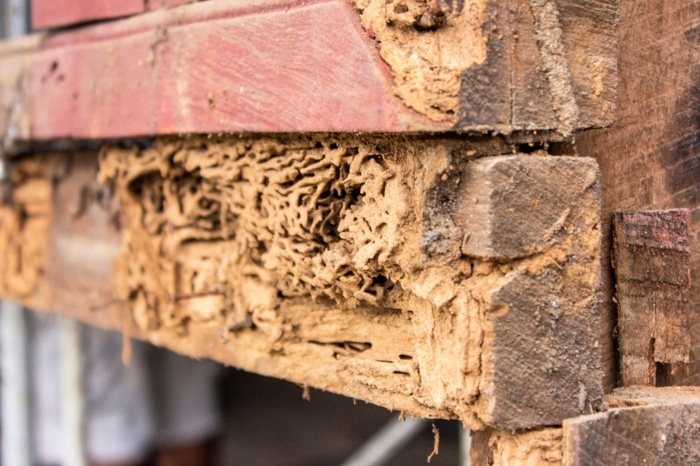Dealing with pesky critters isn’t just about that one-off phone call from a tenant at 2 am, nor is it solely about the yucky factor. For property managers and landlords, ensuring a pest-free environment is integral to maintaining the value and reputation of their property. Besides, nobody fancies an unexpected, multi-legged guest during a property viewing, right?
So, how does one stay a step ahead in this perpetual game of hide-and-seek with pests? By keeping a keen eye out for the early warnings! Here’s a kickstart with the first ten pointers from our robust listicle that’s gonna be your handy sidekick in your mission against infestations.
20 signs of Pest Infestations:
Oddball Scribbles on Walls:
Think your tenant’s kid turned Picasso? Not so fast! Tiny, brown streaks, especially in corners, might actually be fecal markings left behind by roaches.
Mysteriously Nibbled Packages:
If you’re spotting packages or food items with little bite marks, it might be a clear calling card from rodents. Better act quickly before your tenant’s favorite snacks vanish!
Dracula’s Tiny Cousins:
If there are more complaints about mysterious bites than usual, especially after a night’s rest, you could be dealing with a bed bug situation. A thorough mattress check might be in order.
Ants Marching:
A stray ant might not raise alarms. But a consistent trail? Time to track down where these tiny troops are nesting.
Sawdust…but No Woodwork:
Noticed some fine sawdust, but can’t recall any recent carpentry? Those might be the remnants from wood-boring pests like termites or carpenter ants. Examine your wooden structures!
Moths in Closets:
If your tenants are complaining about random holes in their garments or spotting moths in their closets, clothes moths could be the culprits. These critters love to munch on natural fibers.
Rat-a-tat-tat but No Drums:
No, it’s not a budding drummer in Apt. 203. If you hear mysterious scratching sounds, especially during the wee hours, rodents might be having a nightly jam session in your walls or attic.
Silver Streaks in Dark Spaces:
Silverfish love damp and dark areas. If you spot these quick, silver critters darting away when you switch on a light, it’s a sign!
The Unwanted Fruit Bowl Residents:
Fruit flies can become a real nuisance, especially if there’s decaying fruit or food scraps left exposed. A sudden swarm around the fruit bowl or trash can is a clue.
Honey, There’s Mud on the Wall:
Mud tubes crawling up your exterior walls? Termites are probably building highways to their next feast. Don’t let them turn your property into their dining room!
Mysterious Puddles:
Spotting small pools of water but can’t seem to find the source? Check for leaking pipes. These often attract pests like roaches and silverfish who love damp environments.
Spider Web Galore:
It’s not Halloween yet, but those cobwebs adorning every nook and cranny could be hinting at an unchecked spider population. Plus, an abundance of spiders may suggest other pests they’re feeding on.
Night-time Ballet Performances:
If your tenants speak of small bugs that jump when disturbed, it’s probably fleas. Especially worth noting if the tenant has pets.
Winged Ant or Termite?:
Discovering winged insects indoors can be puzzling. Termites and ants both have winged varieties, and both are cause for concern. Analyze their wings and body structure to determine the culprit.
Gnawed Wires & Cables:
When electrical mishaps become the talk of the town, it might not be a manufacturing defect. Rodents love to chew on wires, which can be both dangerous and costly.
Tiny White Dust or Eggs?:
If you’re finding tiny white specks near food sources or in dark corners, they might be pest eggs. Time for a magnifying glass inspection!
Blisters in Wooden Flooring:
Wood that sounds hollow when tapped or has visible blistering could be an indication of lurking termites, chomping away underneath.
Stale Smells in Rarely Visited Corners:
An unexpected, musty odor, especially in corners or basements, can be a sign of mold, which attracts a variety of pests. It’s the kind of perfume that’s far from Chanel!
Droppings in the Pantry:
One of the most straightforward signs. If you find tiny droppings in food storage areas, you’ve likely got rodents or even bigger pests roaming free.
Eerie Silence from the Birds:
If birds suddenly stop frequenting your property or nearby trees, it might be because of a larger predator (like a snake) or an environmental change that has disrupted their food source, both of which are worth investigating.
Get to know about more signs from Signs of Infestations Property Managers Should Look.

What is the best way to prevent pest infestation?
Fortress Foundations:
It all starts with the foundation. Ensure there are no cracks, as they are open invitations for pests. Seal them up good!
Drainage Drama:
Improper drainage can lead to pools of water around your property, becoming breeding grounds for mosquitoes. Make sure you have a functional drainage system.
Killer Kitchen Hygiene:
No crumbs, no pests. Maintain a clean kitchen, especially overnight, and make sure to store food in airtight containers.
Garbage Guardianship:
Don’t let the trash linger. Ensure trash bins are sealed and emptied regularly. It’s surprising how many critters are gourmet fans of garbage.
Firewood Far Away:
Store firewood at least 20 feet away from the building. Termites and ants love making homes in them, and you don’t want those homes too close to yours.
Vigilant Vegetation:
Keep shrubbery and branches trimmed and away from the walls. They can serve as highways for pests into your property.
Screened Windows & Vents:
Ensure windows, doors, and vents are adequately screened. This not only keeps out the larger pests but also the tiniest ones.
Gut Your Gutters:
Keep your gutters clean. Clogged gutters can result in stagnant water, which is a five-star hotel for pests like mosquitoes.
Dry & Dehumidify:
Pests, especially things like silverfish, love damp spaces. Keep basements, attics, and crawl spaces dry and ventilated. Consider using a dehumidifier in these areas.
Partner with Professionals:
Schedule regular professional inspections. Sometimes, the signs of infestation aren’t obvious. Regular checks by pros can keep potential outbreaks in check.
Landscape Logistics:
The design of your property’s landscape plays a key role in pest control. Sloping the landscape away from the building ensures water run-off doesn’t accumulate around the foundation, dissuading pests that thrive in damp conditions.
Wise Wood Choices:
If wooden structures are essential, opt for pest-resistant woods like cedar or redwood. They not only resist decay but are less attractive to many pests.
Mind the Molds:
Fungi and molds attract a multitude of pests. Regularly inspect properties for mold growth, particularly in bathrooms, basements, and other damp areas, and promptly address any found.
External Lighting Lowdown:
Insects are attracted to lights. While having external lighting directly on the property might seem aesthetically pleasing, consider placing lights further away and using halogen lights which attract fewer insects.
Concrete Covers:
Use concrete-based covers in areas prone to burrowing pests. For instance, a concrete patio can deter pests that like to burrow into the ground, such as gophers or moles.
Mailbox Maintenance:
Don’t let your mailboxes become a haven for spiders and ants. Periodically clean, check for webs, and consider using natural repellents.
Breezy Building Materials:
Opt for materials that allow ventilation. Moisture buildup inside walls or under floors is a magnet for pests. Breathable barriers can help prevent moisture buildup.
Interior Inspections:
Regularly inspect the inside of properties, especially in areas not frequently used. Attics, storage rooms, and basements can become unnoticed harborage areas for pests if not checked periodically.
Educate Tenants:
It’s a team game. Offering guidance and educational materials to tenants about proper food storage, waste management, and general cleanliness can amplify your preventative measures tenfold.
Prompt Plumbing:
Leaky faucets or pipes can create water pools, and even a small drip might create the humidity some pests thrive in. Regular plumbing maintenance isn’t just good for the infrastructure but is also a potent pest prevention strategy.
What scenario can lead to pest infestation?
Landscape Logistics:
The design of your property’s landscape plays a key role in pest control. Sloping the landscape away from the building ensures water run-off doesn’t accumulate around the foundation, dissuading pests that thrive in damp conditions.
Wise Wood Choices:
If wooden structures are essential, opt for pest-resistant woods like cedar or redwood. They not only resist decay but are less attractive to many pests.
Mind the Molds:
Fungi and molds attract a multitude of pests. Regularly inspect properties for mold growth, particularly in bathrooms, basements, and other damp areas, and promptly address any found.
External Lighting Lowdown:
Insects are attracted to lights. While having external lighting directly on the property might seem aesthetically pleasing, consider placing lights further away and using halogen lights which attract fewer insects.
Concrete Covers:
Use concrete-based covers in areas prone to burrowing pests. For instance, a concrete patio can deter pests that like to burrow into the ground, such as gophers or moles.
Mailbox Maintenance:
Don’t let your mailboxes become a haven for spiders and ants. Periodically clean, check for webs, and consider using natural repellents.
Breezy Building Materials:
Opt for materials that allow ventilation. Moisture buildup inside walls or under floors is a magnet for pests. Breathable barriers can help prevent moisture buildup.
Interior Inspections:
Regularly inspect the inside of properties, especially in areas not frequently used. Attics, storage rooms, and basements can become unnoticed harborage areas for pests if not checked periodically.
Educate Tenants:
It’s a team game. Offering guidance and educational materials to tenants about proper food storage, waste management, and general cleanliness can amplify your preventative measures tenfold.
Prompt Plumbing:
Leaky faucets or pipes can create water pools, and even a small drip might create the humidity some pests thrive in. Regular plumbing maintenance isn’t just good for the infrastructure but is also a potent pest prevention strategy.
More signs of Pest Infestations for Apartments:
Unusual Odors:
Mysterious, lingering smells can be a red flag. For instance, a musty scent could indicate a cockroach presence, while a urine-like odor might suggest rodents. Such smells, especially in kitchen or storage areas, warrant immediate attention.

Resident Complaints:
Residents are the front line of observation. Frequent itchiness, suspected bite marks, or hearing nocturnal movements should be taken seriously. Such concerns can point to bed bugs, fleas, or rodents making themselves at home.
Evidence of Nesting:
Finding shredded paper, bits of fabric, or other nesting materials in tucked-away areas like behind appliances or in storage rooms can be indicative of rodents seeking a cozy environment.
Grease Marks and Tracks:
Dark, smudgy trails along baseboards, walls, or behind appliances suggest a rodent’s frequent pathway. These marks result from the oils and dirt on their bodies and are a sure sign of an established presence.
Visible Droppings:
One of the more blatant signs, finding pest feces, whether it’s tiny roach droppings or larger rodent pellets, signals an active infestation. Immediate action is crucial, and the type of dropping can help identify the invader.
Damaged Plants:
In apartments with balcony gardens or indoor plants, noticing nibbled leaves or uprooted saplings might suggest pests like aphids or even larger critters seeking food and shelter.
Pantry Havoc:
Discovering hollowed-out grains, pierced food packaging, or tiny larvae can be disconcerting. Such disturbances in pantry areas not only indicate pest activity but also raise health concerns due to potential contamination.
Sounds in the Walls:
Scratching, scuttling, or even faint squeaks from within walls, especially during the quiet of night, can be a telltale sign of rodents or other pests having nested within the building’s cavities.
Recurring Property Damage:
Finding gnawed cables, chewed wallpapers, or mysterious holes in wooden fixtures is more than just a maintenance issue. Such damages often hint at larger underlying pest problems that need addressing.
Increased Bird Activity:
Observing an unusual uptick in birds, especially pigeons or sparrows, around balconies or window ledges can suggest they’re feeding on a lurking insect population within the apartment complex.
Navigating Pest Signs: Property Managers’ Action Plan
For property managers, the appearance of even subtle signs of a pest infestation can be alarming. Not only do they pose potential health risks to residents, but they can also severely impact the reputation of the property. Consequently, understanding the appropriate responses and the significance of quick action is paramount. Here’s a breakdown of what property managers need to do when they encounter these indicators:
Immediate Inspection and Assessment
Upon noticing or being informed of potential pest signs, initiate a thorough inspection. Engage pest control professionals who can accurately diagnose the extent of the problem and identify the specific culprits. Their expertise can guide targeted solutions rather than generalized treatments that might miss the mark.
Prioritize Resident Safety
Always consider the well-being of the residents as paramount. If an infestation is confirmed, communicate transparently with the affected and neighboring units. Offer guidance on immediate steps they can take, such as safeguarding food or avoiding certain areas, to minimize risks.
Swiftly Initiate Treatment
Delays can exacerbate an infestation, leading to a more extensive and expensive eradication process. Once you’ve identified the issue, deploy treatments immediately. Depending on the pest, this might involve chemical treatments, baits, traps, or even heat treatments for pests like bed bugs.
Embrace Preventive Measures
Post-treatment, it’s crucial to ensure pests don’t make a return. Seal potential entry points, maintain cleanliness in communal areas, and advise residents on preventive practices. These steps are not one-off actions but should be integrated into the regular maintenance routine.
Educate the Residents
Host informational sessions or distribute literature detailing ways residents can minimize pest attraction. This could range from proper food storage, regular cleaning, prompt reporting of water leaks, to understanding the risks of second-hand furniture.
Regular Monitoring
Implementing regular pest monitoring systems can be a proactive approach. This can be as simple as periodic inspections or as advanced as setting up monitoring devices in critical areas that can alert to early signs of intrusion.
Maintain Documentation
Always document actions taken, from initial reports to the treatment procedures and follow-up checks. This record not only helps in future prevention strategies but also serves as a transparent communication tool with residents and regulatory bodies if needed.
The Imperative of Prompt Action
The urgency in addressing pest signs goes beyond just the immediate discomfort or health concerns. Here are some of the broader reasons why swift action is non-negotiable:
Protecting Property Reputation
In the age of online reviews and instant communication, word about pest issues can spread rapidly, impacting a property’s reputation. Addressing and resolving issues swiftly can mitigate long-term reputational damage and assure current and potential residents of the property’s commitment to their well-being.
Financial Implications
Unchecked infestations can escalate into extensive damage, from gnawed wiring and structural damage to contaminated water sources. Early intervention can prevent such costly repairs and the added expenditure of large-scale pest control operations.
Legal Ramifications
In many jurisdictions, property managers have a legal obligation to provide pest-free living conditions. Negligence can lead to lawsuits, penalties, and even property sanctions.
Health and Wellness
Pests like rats, roaches, and bed bugs can be carriers of diseases. An unaddressed infestation can pose significant health risks to residents, potentially leading to a broader public health concern.
Preservation of Community
The unease and discomfort stemming from pest infestations can strain the sense of community within a property. Residents might be hesitant to use communal areas, or in extreme cases, might even consider moving out. Prompt action can prevent such disruptions and maintain harmony.
Pest Share: Revolutionizing Pest Management for Property Managers
In the challenging arena of property management, the last thing a manager needs is the added stress of dealing with unexpected property pest infestations. Enter Pest Share, an innovative platform specifically designed to streamline and optimize the pest control process for both residents and property managers. With its unique approach, Pest Share seamlessly bridges the gap between residents experiencing pest issues and the qualified professionals who can address them.
When residents detect a pest problem, they can swiftly log into the Pest Share system to report it. The platform’s cutting-edge technology efficiently identifies the pest through a detailed questionnaire. Once the pest is identified, the information is relayed to vetted service providers in the vicinity. Critical infestations, like those caused by termites, even trigger immediate notifications to property managers, ensuring they are always in the loop. The result? No more scrambling to find a reputable pest control service or negotiating terms. The process is transparent, quick, and efficient.
For property managers, Pest Share eliminates the logistical headaches often associated with pest control. By connecting with trusted local pest control companies, managers can be assured of timely and effective treatments. Moreover, with the resident coverage feature, disputes over treatment costs become a thing of the past. Both residents and property managers can heave a sigh of relief knowing that expert help is just a click away.





